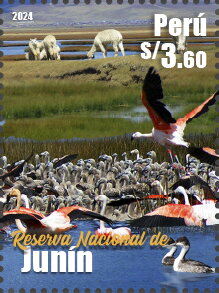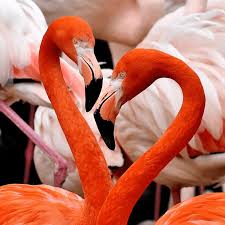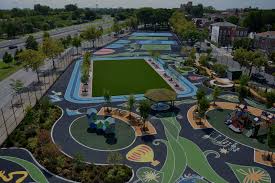Stamp: Junín Nature Reserve, 50 Years (Peru 2024)
Junín Nature Reserve, 50 Years (Peru 2024)
23 September (Peru ) within release Junín Nature Reserve, 50 Years goes into circulation Stamp Junín Nature Reserve, 50 Years face value 3.60 Peruvian nuevo sol
| Stamp Junín Nature Reserve, 50 Years in catalogues | |
|---|---|
| Colnect codes: | Col: PE 2024.09.23-01a |
Stamp is square format.
stamp from souvenir sheetAlso in the issue Junín Nature Reserve, 50 Years:
- Souvenir Sheet - Junín Nature Reserve, 50 Years face value 3.60;
- Stamp - Junín Nature Reserve, 50 Years face value 3.60;
Stamp Junín Nature Reserve, 50 Years it reflects the thematic directions:
Flamingos or flamingoes (/fləˈmɪŋɡoʊz/) are a type of wading bird in the family Phoenicopteridae, which is the only extant family in the order Phoenicopteriformes. There are four flamingo species distributed throughout the Americas (including the Caribbean), and two species native to Afro-Eurasia.
A landscape is the visible features of an area of land, its landforms and how they integrate with natural or man-made features. A landscape includes the physical elements of geophysically defined landforms such as (ice-capped) mountains, hills, water bodies such as rivers, lakes, ponds and the sea, living elements of land cover including indigenous vegetation, human elements including different forms of land use, buildings and structures, and transitory elements such as lighting and weather conditions. Combining both their physical origins and the cultural overlay of human presence, often created over millennia, landscapes reflect a living synthesis of people and place that is vital to local and national identity. The character of a landscape helps define the self-image of the people who inhabit it and a sense of place that differentiates one region from other regions. It is the dynamic backdrop to people’s lives. Landscape can be as varied as farmland, a landscape park, or wilderness. The earth has a vast range of landscapes, including the icy landscapes of polar regions, mountainous landscapes, vast arid desert landscapes, islands and coastal landscapes, densely forested or wooded landscapes including past boreal forests and tropical rainforests, and agricultural landscapes of temperate and tropical regions.
A park is an area of natural, semi-natural or planted space set aside for human enjoyment and recreation or for the protection of wildlife or natural habitats. Urban parks are green spaces set aside for recreation inside towns and cities. National parks and country parks are green spaces used for recreation in the countryside. State parks and provincial parks are administered by sub-national government states and agencies. Parks may consist of grassy areas, rocks, soil and trees, but may also contain buildings and other artifacts such as monuments, fountains or playground structures. Many parks have fields for playing sports such as baseball and football, and paved areas for games such as basketball. Many parks have trails for walking, biking and other activities. Some parks are built adjacent to bodies of water or watercourses and may comprise a beach or boat dock area. Urban parks often have benches for sitting and may contain picnic tables and barbecue grills.



